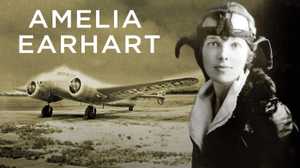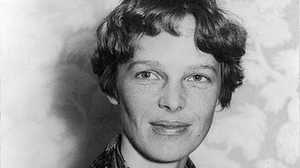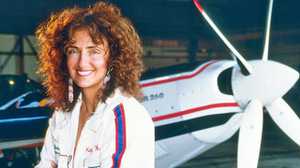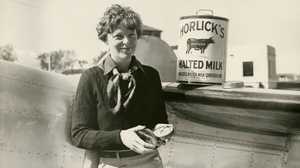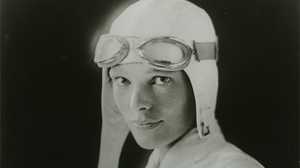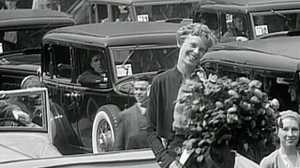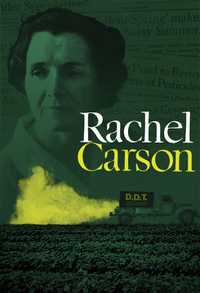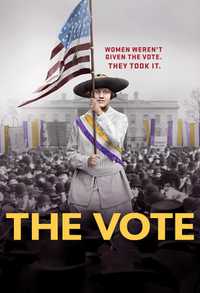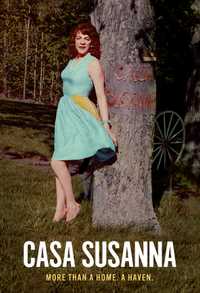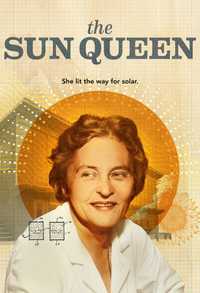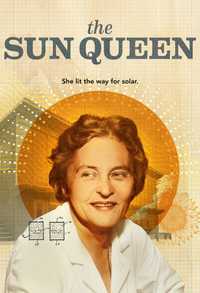Narrator: On a summer day in 1932, Amelia Earhart completed another record-breaking flight. A few weeks earlier, she had made history by being the first woman to fly solo across the Atlantic. Now she was a superstar and her every move fascinated the public.
Amelia Earhart, Interview (archival): Yesterday, I hopped off from Los Angeles about noontime and landed in Newark this morning after a non-stop transcontinental trip.
Reporter, Interview (archival): And what did you carry on the trip?
Amelia Earhart, Interview (archival): You mean to eat?
Reporter, Interview (archival): Yeah, to eat and drink.
Amelia Earhart, Interview (archival): Well, I carried some water, of course, because my cockpit is very warm, and I carried a sandwich, in case. I didn’t eat it, though. I carried some hot chocolate and the all reliable tomato juice.
Reporter, Interview (archival): What kind of a sandwich was it?
Amelia Earhart, Interview (archival): A chicken sandwich.
Gore Vidal, author: I have walked the streets with many famous people in my time, from Greta Garbo to Paul Newman to Eleanor Roosevelt. No one got the crowd that Amelia got. She was — I must say it was beyond stardom. It was a strange continuum that she and Lindbergh occupied. They were like gods from outer space.
Doris Rich, biographer: And people would just stand and stare at her.
Narrator: Amelia Earhart was a legend, the first modern American heroine, adored because she was daring and successful in a man’s world, and because she was magnificently promoted in the press and newsreels of the time. Yet Amelia Earhart, the best known woman in America, would always remain curiously remote. “I don’t know you at all,” her closest friend wrote. “I doubt anyone does.”
Doris Rich, biographer: The one thing that she really feared in life was that nothing would happen. She had to have an important life, and that meant you had to have adventure. You had to try things that were exciting. And that — all her life, there’s no doubt that she needed this and believed this was the way to live. Better to die young, but live.
Narrator: In 1937, Amelia Earhart decided to go for the one record in aviation no one, man or woman, had ever attempted before — to fly around the world at the equator. It would be the most dangerous flight of her life. To succeed, Earhart would need months of preparation and a lot of luck. In the end, she had neither.
First singer: Come, Josephine, in my flying machine/ Going up she goes, up she goes/ Balance yourself like a bird on a beam/ In the air she goes. Where?/ There she goes, up, up a little bit higher. Oh, look…
Narrator: Like most Americans, Amelia was fascinated by the sheer novelty of flight. On Christmas Day, 1920, when she was 23 years old, her father took her to the opening of a new airfield in Long Beach, California. There she watched pilots in wood and fabric machines perform daredevil stunts. A few days later, when she paid $5 for her first ride, she knew that flying was more than a passing fancy. “As soon as we left the ground,” she wrote, “I knew I myself had to fly. 'I think I’d like to fly,’ I told my family casually that evening, knowing full well I’d die if I didn’t.”
Amelia Mary Earhart was raised by her domineering mother to be a proper Victorian young lady, but she never was.
Doris Rich, biographer: When Earhart was seven years old, she had a new sled and she went to the top of the hill with her sister Muriel and she, instead of sitting on it as her grandmother had said one must, she flung herself in a manner called “belly slamming” and went tearing down the hill. A horse and wagon was crossing on the cross street. She went right under that horse’s belly. She missed both sets of legs and she emerged triumphant, waving at her sister afterwards. This is an indication that came up again and again later in life, that she took good luck for granted.
Narrator: Amelia was resilient in spite of a difficult childhood. Born in Kansas on July 24, 1897, she and her younger sister Muriel had an unstable life, shuttling back and forth between their grandparents’ luxurious home in Atchison and their parents’ meager existence in Kansas City. Amelia’s father, Edwin, was a charming man who earned a modest living as a lawyer, but it was never enough for Amelia’s mother Amy. During the course of their troubled marriage, Edwin became an alcoholic. When Amelia was 12, the Earharts left Kansas, moving around the Midwest, settling wherever Edwin could find work. Amelia adored her father, but he let her down so often she learned early on to be self-reliant. During high school, she kept an unusual scrapbook of articles about women pioneering in new careers. The scrapbook reveals a young girl with unconventional dreams.
Nancy Morse, Earhart’s cousin: She was a loner, you know. She had seen so much change in her childhood — she’d lived in many different places, she’d gone to many different schools — and naturally, this resulted in a kind of restlessness. I think Amelia got easily bored.
Narrator: Sent to a finishing school in Pennsylvania, Amelia didn’t fit the mold and was kicked out for stunts like walking on the roof in her nightgown. She was a rebel and had high ideals. During World War I, she nursed wounded veterans in Canada and briefly pursued a career in medicine.
In her early 20’s, Earhart was living in Los Angeles with her parents when she discovered flying. At Kinner Airfield, she met a young woman who agreed to teach her to fly for a dollar a minute. Earhart regularly walked the three miles to the airfield, took menial jobs to pay for lessons, and drove a gravel truck for a construction company to raise money to buy her own plane. Amelia’s mother demanded her daughter stop driving a truck and act like a lady. Reluctantly, she helped Amelia out, and by her 25th birthday, Earhart finally had the cash she needed. She bought a new biplane and painted it bright yellow.
The amateur flier was also a novice poet. In the spring of 1921, she submitted several poems to a journal under the pen name Emil A. Hart. They were never published, but one was about her newest passion.
From an airplane, even the watchful purple hills that hold the lake could not see so well as I the stain of evening creeping from its heart.
From the beginning, Earhart saw herself in the vanguard. She was a flier, a poet and an amateur photographer. She was supporting herself and though there were suitors, she rejected a traditional marriage as too confining. “I don’t want anything all of the time,” she said.
First Newsreel Announcer (archival): And my baby is plotting the darndest revolution in history. “It won’t be long now,” announce the girls as they head from the polling booth to the barbershop, disregarding the warning of an alarmed press…
Narrator: With the suffrage battle behind them, women like Earhart set out to redefine themselves. In keeping with the times, she cut her hair, but cut it inch by inch so her mother wouldn’t notice. In 1925, Amelia moved to Boston, finding work in a settlement house with the children of Chinese and Syrian immigrants. Her supervisor thought she was a natural and promoted her quickly. Earhart felt she’d found her true calling. Flying was now a weekend hobby, but in the spring of 1928, George Palmer Putnam, a successful publisher and promoter — known as G.P. — came into Earhart’s life.
Brad Washburn, explorer, aerial photographer: G.P. was a very clever publisher. Every series of years you have somebody who rises to the top of the publishing business and then fades gently down and somebody else — and there’s a publisher who is the top of the pile. And in that moment, Putnam’s was and Putnam was always in there at the kill and always getting the number one fellow to write the book.
Narrator: Putnam’s best seller was a book by Charles Lindbergh about his historic Atlantic solo flight the year before. Now G.P. had a new book in mind. He had been hired to find the right sort of girl to be the first woman to fly across the Atlantic. Earhart’s name had surfaced through Boston aviation circles, and she was invited to New York to meet G.P. Her own account of the meeting reveals just how shrewd she was. “If I were found wanting on too many counts, I should be deprived of a trip. On the other hand, if I were just too fascinating, the gallant gentleman might be loath to drown me. It was therefore necessary for me to maintain an attitude of impenetrable mediocrity.”
Doris Rich, biographer: And G.P. knew when he looked at her that this was “Lady Lindy.” This was going to the female Lindbergh.
Narrator: Earhart’s remarkable resemblance to Lindbergh, the most famous man in America, made her a publicist’s dream. Putnam asked her to make the transatlantic flight not as the pilot but as a passenger. Amelia jumped at the chance. From this point on, she would be promoted not only for her flying skill, but also for her wholesome beauty and personal appeal. Nonetheless, the flight was a very dangerous undertaking.
Susan Ware, historian: It did take great courage to say yes to this proposition, to agree to fly the Atlantic. I think 14 people had been killed just in the year since Lindbergh had tried, including three women. So that when she took off in that plane, even as a passenger, she did not know that she was going to make it. She could have lost her life.
Narrator: The Friendship flight, as it was called, was planned in secrecy, both to capitalize on the drama of the event and to beat out two other women contemplating the same mission. On July 3, 1928, decked in a fur-lined flight suit, Amelia joined pilot Wilmer Stultz and mechanic Louis Gordon. George Putnam was there to see them off. Without fanfare, the fuel-laden bright orange Friendship took off from Boston Harbor in the wee hours of the morning.
Doris Rich, biographer: The plane barely got off. When it did, it tipped and a door opened, and she went rolling across the floor of the airplane, managed to grab a fuel tank and just steadied herself in time while the engineer leaped over and shut the door and actually tied it shut with a rope and off they went. The whole Friendship flight was pretty much one occasion like this after another. They had to land first in Nova Scotia and they waited 13 days in the pouring rain. And meantime, the pilot, Wilmer Stultz, proceeded to be dead drunk most of the time. On the 13th night, they sat down together and they said, “No matter what shape Stultz is in, we’re leaving tomorrow.”
Narrator: Within hours after takeoff, the plane was enveloped by fog, then snow and ice. The radio went dead. They were flying blind. With little fuel remaining, they finally spotted land. After 20 hours and 40 minutes, the Friendship set down in Burryport, Wales. In no time at all, 2,000 people were at the dock to greet her, clamoring to shake her hand and get her autograph.
Susan Ware, historian: I don’t think she had any idea that she would encounter the kind of celebrity that she did when she agreed to be part of the Friendship crew. I think she was just dumbfounded that people were so concerned about her. She kept saying, “But the boys, they did all the flying.”
Narrator: But Stultz and Gordon were ignored by the press. The hero was the passenger. When the Friendship landed in England for the official welcome, another huge crowd waited to see Amelia. Just weeks earlier, Earhart was earning $60 a month as a social worker. Now she was having tea with George Bernard Shaw, dancing with the Prince of Wales, and dining with Lady Astor. George Putnam had picked a winner.
British Newsreel (archival): Here you see “Lady Lindy,” whose triumphant flight across the Atlantic is the admiration of the whole world. What a wonderful woman, and isn’t she like Lindbergh?
Narrator: Back home, the fliers received America’s version of a royal welcome — a New York City ticker tape parade. Amelia was always quick to note that she didn’t deserve the credit and said she had merely been a sack of potatoes who kept the log, but nobody seemed to listen. After New York, Amelia was honored in celebrations around the country, all arranged by the consummate promoter, George Palmer Putnam.
Gore Vidal, author: I never knew anybody who liked George Palmer Putnam. It was quite interesting. Everybody who knew him disliked him. Some people disliked him more than others and some people disliked him and found him amusing, and some people disliked him and found him unamusing.
Doris Rich, biographer: He was a superb editor and a better publicist, could be enormously charming and be totally insulting at times to people. His language ranged from the erudite to really ugly profanity. He was just a very complex, driven man.
Narrator: In the summer of 1928 at the age of 31, Earhart was set up in G.P.'s elegant home in Rye, New York to write what G.P. hoped would be his next best seller, 20 Hours 40 Minutes: The Story of the Friendship Flight. In the fall, Amelia took off on a month-long trip around the country in a small biplane Putnam had bought her, giving hundreds of speeches and interviews G.P. had scheduled. In effect, he became her manager. He told her not to wear hats because they obscured her tousled hair. He told her to close her mouth when she smiled, to hide the space between her two front teeth. Amelia and G.P. were inseparable and there were rumors of an affair.
Sally Chapman, George Putnam’s granddaughter: I think that my grandfather and my grandmother had not been happy for some time and when Amelia came into the picture, my grandfather of course became busier and busier with her and started spending less time and less time at home with my grandmother. One thing led to another and a relationship did develop. What can I say? That’s what happened.
Narrator: Being “Lady Lindy” was a full-time job. “Here I am, jumping through hoops,” she wrote, “just like the little white horse in the circus,” but Earhart was ambitious and willing to pay the price. G.P. scheduled a growing number of appearances, lectures and product endorsements. He also arranged a position for her as the aviation editor of Cosmopolitan magazine. Her celebrity status made her invaluable to the emerging airline industry. She became fast friends with one of its pioneers, Eugene Vidal, Gore’s father, and together they helped launch the country’s first passenger airline, Transcontinental Air Transport.
Second Newsreel Announcer (archival): The big tri-motor, all-metal plane is ready and waiting, equipped like a Pullman car. Its roomy cabin is well lighted and heated in wintertime.
Gore Vidal, author: And my mother was probably the first airline stewardess, just to make sure that the people were contented and what would they eat, let us say. And she was always dieting and very grand. She thought consommé would be perfect. Well, they were all scalded on that flight, 'cause the planes would be going up and down like that, and the fumes from the gas were terrible inside. And in front of every seat, there’d be this huge ice cream, cardboard cylinder in which people would vomit during the flight, and it was a mess.
Narrator: At the dawn of aviation, women were not trusted to pilot passenger planes. Earhart’s contribution was confined to public relations.
Passenger (archival): You know, Miss Earhart, we’ve had a marvelous trip and going back the same way.
Amelia Earhart (archival): I’m glad to hear it.
Narrator: To stay in the limelight, Earhart needed another high-profile event. Just before her 32nd birthday, Amelia and George used the proceeds from her lectures and endorsements to buy a bigger and faster plane. Flying her new Lockheed Vega, she could now compete with the top pilots in the first cross-country Women’s Air Derby. In the summer of 1929, Earhart was one of 20 contestants to enter the derby. Bobbi Trout was another.
Bobbi Trout, record-breaking aviator: We were characters and a devil breed. That was all there was to it. I think that most women who really took up flying knew that it was a dangerous business in those days, in the early days, but it was such an interesting and such a wonderful thing to do so, well, it was like a magnet, you know. It just drew people to it.
Second Reporter (archival): In ship number six is the world-famous Amelia Earhart, first woman to fly across the Atlantic Ocean. She is flying a Lockheed Vega.
Narrator: But Earhart’s flying ability had not caught up with her fame, and some of the other fliers knew it.
Elinor Smith, Voted Best Woman Pilot, 1930: It was a skill. It was not like today where you can almost do it on the numbers. So you had to fly every single day. Maybe Amelia would have been a natural had she had the proper instruction and the amount of practice that went into it, but she never seemed to practice, to really stick at it.
Narrator: After eight days, 15 women crossed the finish line in Cleveland. Amelia came in a distant third.
Elinor Smith, Voted Best Woman Pilot, 1930: That was the fastest and the most powered airplane in that race. She still couldn’t land it in Cleveland in front of everybody. Just ka-bum, ka-bum, ka-bum, ka-bum all the way across the airport.
Narrator: After the air derby, Amelia was thrown into emotional chaos. She was supporting her mother and sister, her father had died of cancer, and G.P., who had finally gotten a divorce, was pressuring her to marry him. Speculation about a possible marriage was front-page news for weeks. When asked about her plans by a reporter, Amelia answered, “Sometime in the next 50 years I may be married,” but privately Amelia had made her decision.
Bobbi Trout, record-breaking aviator: The reason I think Amelia gave in to G.P. and married him was because he was a darn good promoter, and after all, the promotion that he did would bring in money and that was hard to get during the Depression, and she was smart enough to know that.
Sally Chapman, George Putnam’s granddaughter: This is what she wanted. When she met him, she knew that this man could help her get this job done and he knew when he met her that this was going to provide him with a new future. So it was an incredible combination, these two people together.
Gore Vidal, author: Well, she was marrying her manager. This is what great actresses do. At some point, every great actress marries the manager, or settles down in a relationship with the manager. She settled down with her manager. He made life very easy for her in many ways and heaven knows he was a hustler, he was a promoter, and she was ambitious.
Narrator: Whatever her reasons for agreeing to marry G.P., Amelia had not resolved her ambivalence. On the morning of the wedding, she presented him with a startling letter. “Dear Gyp: You must know again my reluctance to marry. I feel the move just now is foolish as anything I could do. I may have to keep some place where I can go to be myself now and then. I cannot guarantee to endure at all times the confinement of even an attractive cage. I must exact a cruel promise and that is that you will let me go in a year if we find no happiness together.” Wearing a tailored brown suit, Amelia Earhart married George Putnam at a small private ceremony on February 7, 1931. As if to assure herself and the world that marriage wasn’t a cage, she took no honeymoon and was back at work the next day.
Before long, Earhart and Putnam were secretly planning another flight. Amelia wanted to be the first person to fly the Atlantic alone since Lindbergh. This time she would pilot the plane and finally prove her flying ability. But that wasn’t the only reason.
Doris Rich, biographer: She was beginning to understand what G.P. was teaching her, that you don’t stay in the headlines forever for one deed, that there must be a continuing and accelerated, almost, series in which you prove again and again, and more so, if possible, how good you are.
Narrator: But when Amelia announced the Atlantic flight, even she seemed to have trouble believing she could do it.
Amelia Earhart (archival): I think I’m ready for a transatlantic hop. I’ve chosen to use a plane with which I am familiar, having flown it at least three years. I think I couldn’t have undertaken this trip unless I had confidence in the plane, the engine and perhaps my own experience. Well, how’s the weather now, Bert?”
Narrator: Delayed for weeks because of bad weather, Amelia was ready to take off from New Jersey. G.P. arranged for newsreel cameras to cover the takeoff.
George Palmer Putnam (archival) Well, you’re off. Say, how does it look in there?
Amelia Earhart (archival): Everything is ready.
George Palmer Putnam (archival): Fine. 'Bye.
Amelia Earhart (archival): Goodbye.
Narrator: Amelia was too embarrassed to kiss G.P. goodbye, so there was a second take.
George Palmer Putnam (archival): Please don’t forget to phone just the minute you get there, eh?
Amelia Earhart (archival): I will.
George Palmer Putnam (archival): Goodbye.
Amelia Earhart (archival): So long.
Narrator: On the fifth anniversary of Lindbergh’s flight, the Vega was ready. Ten people had died trying to cross the Atlantic since Lindbergh, and Earhart’s mechanic thought she had a one-in-100 chance of surviving. A poem Amelia wrote reveals her feelings about taking such a risk.
Courage is the price that life exacts for granting peace. The soul that knows it not knows no release from little things, knows not the livid loneliness of fear, nor mountain heights where bitter joy can hear the sound of wings.
Doris Rich, biographer: She was four hours out when she ran into a storm. She would go high and the plane would ice. Then she’d go down until she could see the waves to get the ice off. She had no radio contact with anyone. The manifold on her engine broke and the flames from the backfire from it were coming out. There was a gas gauge over her head that began to leak and the gasoline was dripping down over her forehead and into one eye.
Narrator: Earhart’s navigation was off and she almost missed the northern tip of Ireland. But after 15 hours in the air, she landed safely in an isolated field in Londonderry. The next day, G.P. sent in the newsreel cameras and Amelia restaged her arrival.
Third Newsreel Announcer (archival): Journey’s end. There she is, safe and sound on a farm in Ireland, having just completed the first flight by a woman across the Atlantic. And here are the good farmer folk Amelia gave the surprise of their lives. Those messages she holds are congratulations from all parts of the world.
Narrator: In London, Paris and Rome, Earhart was a sensation. Everywhere she went, she was treated like royalty. G.P. met Amelia in Paris. Thousands of spectators lined the route to her hotel and others shouted below her balcony until she and G.P. came out to greet them. In New York, the ticker tape parade was for Amelia alone and this time she deserved all the credit.
Second singer (archival): You took a notion to fly 'cross the ocean/ Our American girl/ Finding your way in the dark/ American Joan of Arc/ Everybody thinks you’re wonderful…
Gore Vidal, author: In the Depression, people wanted idols, of course, to distract them from everyday reality. Aviation was an alternative. Aviation was literally heavenly compared to what was going on on earth, so she was very much part of that. She showed what a woman could do and that a woman was no different from a man when it came to flying an airplane.
Narrator: Earhart’s style was a unique blend of the masculine and feminine, and it made her enormously appealing.
Susan Ware, historian: The technology, I think, that affected Amelia the most was the newsreel. They were like the movies. They were still very new. And for people to go into a darkened movie theater and see these images from Paris or Ireland, a place they had never been — a lot of what Amelia did was similar to being a Hollywood star. She tried to keep her name before the public and she tried to keep the public interested in her and they responded. And that’s very similar to what a Katharine Hepburn or a Bette Davis was doing.
Narrator: G.P was now an executive at Paramount Pictures. He and Amelia courted celebrities because it was good business and business was the name of the game. To keep her name on the front pages, to finance her expensive flights and to support their lavish lifestyle, Earhart depended on the lecture circuit. In a good week, she could earn over $2,400, the equivalent of $30,000 a week today.
Doris Rich, biographer: It was a treadmill, an unbelievable treadmill of lecture after lecture night after night. The ladies’ committee sometimes asked for breakfast, certainly for lunch. Then she gave a speech that afternoon. Then that night to the Chamber of Commerce she gave another speech. And then back in the car at midnight and on to the next town. And this will go on for four months in a row.
Narrator: Earhart had a strong social conscience and now used her fame to promote her causes. She preached pacifism to the Daughters of the American Revolution. She spoke out on behalf of commercial aviation, even enlisting her good friend Eleanor Roosevelt in the effort. And everywhere she went, Amelia crusaded for women.
Amelia Earhart (archival): I’ve had practical experience and know the discrimination against women in various forms of industry. A pilot’s a pilot. I hope that such equality could be carried out in other fields so that men and women may achieve equally in any endeavor they set out.
Narrator: There was precious little time for her private life. Whenever she could, she would retreat to Rye, New York. Amelia wrote to her mother, “I am much happier than I ever expected I could be. I believe the whole thing was for the best.”
Doris Rich, biographer: They seem to have been, at least for the first five or six years of the marriage, a good match. She seemed to find him very attractive. At the same time, there was not the sort of warmth that one expects in a so-called happy marriage. There wasn’t evidence of it.
Sally Chapman, George Putnam’s granddaughter: When Amelia and my grandfather were in public, they were very businesslike, but the minute they stepped inside their home, they became a married couple. She was caring and so was he, but never in public.
Narrator: By 1935, Earhart’s public image was losing its luster and the demand for her on the lecture circuit was drying up. In the winter she set a world record, flying from Hawaii to the mainland. Throngs of people waited to greet her, but Earhart and Putnam were criticized by the press for financing the flight with money from Hawaiian business interests. Emotionally and physically exhausted, Amelia was hospitalized with a severe sinus infection and then bedridden for weeks with back problems.
Doris Rich, biographer: Earhart was truly a frail woman all of her life, assailed by a considerable amount of illness and that it was sheer willpower that kept her going. Always when she flew she was sick to her stomach. She was delicate.
Amelia Earhart (archival): I christen thee Resolute.
Third Reporter (archival): She did all right that time.
Fourth Reporter (archival): You get better every time.
Narrator: When she recovered, Amelia went back to work and to whatever publicity stunts she and G.P. could manufacture.
Announcer (archival): Something really new, a captive parachute.
Narrator: Though by this time Amelia certainly didn’t need another record, she just couldn’t stop.
Sally Chapman, George Putnam’s granddaughter: I think there was a certain amount of insecurity in her and a determination to prove herself to herself and to the world. And I think she used flying to accomplish that, but I don’t think she was ever really satisfied. I don’t think there was ever a flight that made her feel like she had done everything she needed to be for herself.
Narrator: In 1936, Amelia Earhart announced the most ambitious flight of her life.
Amelia Earhart (archival): The contemplated course covers about 27,000 miles. It will be the first flight, if successful, which approximates the equator. Indeed, I cross the equator four times. I hope to fly from Oakland to Honolulu, then Howland Island, then to the northern tip of Australia.
Narrator: Whatever her motives for taking this flight, Amelia Earhart wanted it to be her last. “I have the feeling there’s just one more good flight left in my system and I hope this is it,” Amelia told a good friend. “It is my swan song as far as record-flying is concerned, my frosting on the cake.”
Elinor Smith, Voted Best Woman Pilot, 1930: She had to make this road flight for the record, one. Next, she could have made enough on that flight from the advertising and all that she wouldn’t have had to work anymore during her lifetime.
Narrator: The world flight was an expensive undertaking. The plane alone cost a staggering $80,000. G.P. was able to raise most of the money from Purdue University in Indiana, where Earhart was an aviation adviser and a career counselor to women. The Lockheed Electra was the most advanced aircraft to date. It was overhauled for the long flight by replacing the passenger seats with extra fuel tanks. To deflect criticism that this flight was a self-serving stunt, Earhart presented her Electra as a laboratory for aviation research.
Amelia Earhart (archival): It’s a real flying laboratory equipped with the latest of instruments, and I hope to accomplish something really worthwhile in aviation scientifically. I hope the experiments will include altitude flying and also long distance work.
Elinor Smith, Voted Best Woman Pilot, 1930: It had no scientific value. It had — all of the legs of it had been flown at one time or another. The airplane was certainly tested and retested and had been flown commercially. So there was no real reason for it, but again, G.P. could see the publicity value of it.
Narrator: Amelia and G.P. needed all the publicity they could get. With few aviation records left to break, Earhart had to work harder and harder. In addition to preparing for the world flight, she was supervising construction of a lavish new house in Hollywood, campaigning for Roosevelt and promoting a new franchise, Amelia Earhart Luggage.
Doris Rich, biographer: There was a lack of focus in this whole undertaking and the longer it went on — the preparations went on, the more unfocused she became. She was physically and emotionally exhausted, which had much to do with the failure of it. She simply was not preparing properly for it.
Gore Vidal, author: It’s hard work being Amelia Earhart and eventually it’s monotonous work. It is the same number you must play and some people get tired of their own legends. I don’t think she was eager to take that flight. She was pretty sick of it all. She was certainly sick of G.P., her husband, who was constantly pushing her. Right after that, he had a, I don’t know, a lecture tour for her. He had this, he had that. She was to endorse 32 products. I mean, she was like a rock star and she was being pushed and pushed and pushed.
Sally Chapman, George Putnam’s granddaughter: I think it’s believed that she was the pilot and he was the pushy promoter, but in fact, she was an equal part of this business team. She knew what she wanted. She knew the flight she wanted to take. She knew the sponsors she wanted to get and between the two of them, they accomplished it.
Narrator: From the outset, Amelia had imagined this flight as a solo adventure, but in the course of preparation she realized that she would need a navigator, especially for the most dangerous leg of the trip, a 2,500-mile journey across the Pacific to Howland Island, a tiny atoll only a mile and a half wide. Brad Washburn was interviewed for the job.
Brad Washburn, explorer, aerial photographer: Amelia spread all her maps out on the floor and G.P. sat down like I’m sitting here and we were on the floor in front of them with all these maps. And we chatted our way all the way around the world, almost. When she began to describe her long flight — as I recollect it was a couple of thousand miles — to Howland Island — you’ve got to remember that Howland Island, as I recollect — I wish I had a map of it here, but I had a pretty good visual picture of the damn thing and it was a little sliver of an island about a mile and a quarter long and very narrow. You either hit Howland Island or you don’t hit nothing [sic].
Narrator: Earhart planned to hit Howland Island using a compass course and celestial navigation, but for such a long flight over water out of reach of land, new sophisticated radio equipment would also be essential.
Doris Rich, biographer: She did not like radio communication, there’s absolutely no doubt about it. She not only didn’t bother to learn it, but she didn’t really find it necessary. There is a hint here of the ego that all great explorers and adventurers have. They have a certain faith that they’re going to make it.
Narrator: Ultimately, Amelia assembled a stellar team. She hired stunt pilot and friend Paul Mantz as her technical adviser; Harry Manning, an experienced marine navigator and expert radio man; and Fred Noonan, formerly a navigator with Pan Am. On March 20, 1937, Earhart and the crew started to take off from Hawaii on the first leg of the world flight, but at the far end of the runway, Amelia lost control of the plane. The Electra crashed.
Doris Rich, biographer: After she cracked up the plane in Honolulu, she felt fear for the first time, definitely. The immensity of the project suddenly hit her. She knew that if she lost that plane or failed in this, they were dead broke, both of them.
Narrator: George and Amelia were under a great deal of strain. There were rumors the marriage was falling apart. Amelia even confided to several friends that she was fed up with G.P., but a letter he wrote to her leaves a different impression. “We both recognize the hazards, and I love you dearly. I don’t want you to run risks and I don’t want to run the risk of perhaps having to go on without you. That makes me terribly sorry for myself, entirely disregarding your end of it. But gosh, once this is out of your hair, what a very happy, interesting time we can have. We can have it, too, should you for any reason decide to quit.” But Earhart didn’t quit. Together, Amelia and G.P. raised $34,000 to repair the damaged Electra.Because of changing weather conditions, they had to map out a new route and rearrange visas, landing permissions and ground crews in more than 20 countries.
And then there were problems with the crew. Harry Manning, the only one with radio experience, dropped out, some say because he had lost faith in Amelia. Fred Noonan would now be Earhart’s navigator. He was the best in the business, but he was also a heavy drinker. Throughout the planning of the flight, G.P. and Paul Manse, Earhart’s technical adviser, constantly argued over money. A few days before departure, Manse was edged out. That left G.P., who knew nothing about flying, in charge of the preparations.
With Manse gone, Amelia made several critical decisions on her own. She chose not to take a vital piece of equipment, a trailing wire antenna that she found awkward to use. She also left behind her Morse code key because she’d never learned to operate it properly. Some of Amelia’s friends, concerned about her mental state, advised her not to go forward with the flight.
Brad Washburn, explorer, aerial photographer: This whole array of information on the one hand and what she did with it and how she ignored so many fundamentally important things made you really think that she was pathologically optimistic.
Narrator: Before the flight, Amelia and George spent the day with his son and daughter-in-law.
Sally Chapman, George Putnam’s granddaughter: Mom and Dad and Grandpa George and Amelia had been together the night before. They were staying in the same hotel together. They got in the car together and they drove to the airport. And she said it was very quiet. They touched each other a lot, they held hands. It was a very tender time.
Narrator: The morning of June 1, 1937, Earhart and Fred Noonan took off from Miami. At the last minute, Amelia left behind her parachute, her life raft and even her good luck charm, an elephant-hair bracelet. For six days, she flew along the coast of Central and South America and then across the South Atlantic to Africa. Gore Vidal recalls talking to Amelia beforehand about that part of the flight.
Gore Vidal, author: She was showing us the flight and I said, “What part bothers you the most?” “Oh,” she said, “Africa. That terrifies me. If you were forced down in those jungles, they would never find you. And there’s a lot of it — and you look at the equator, there’s an awful lot of Africa, it’s very fat.” And I said, “Well, what about the Pacific? That’s even fatter.” And she said, “You can’t miss an island, no matter where you are at that latitude.”
Narrator: Earhart flew over Africa without incident and continued over Arabia to Karachi and Calcutta. She fought monsoons that beat the paint off her airplane en route to Singapore. Then in Java, she took a short rest before flying onto Australia and finally to Lae, New Guinea. This would be her last stop before the long Pacific leg to Howland Island. Amelia called the Herald Tribune office in New York where G.P. and Gene Vidal were waiting to hear from her.
Gore Vidal, author: Well, just the night before the final flight, she reported in and they had a code phrase, “personnel problems,” which meant Noonan was back drinking. And my father said, “Just stop it right now and come home,” and G.P. agreed and said, “Come back, abort the flight, forget it, come home.” And then she said, “Oh, no,” and she said, “I think it’ll be all right,” something like that. So you may put that down to invincible optimism or it may have been huge pessimism.
Doris Rich, biographer: By the time Amelia arrived in Lae, which was almost three-quarters of her entire journey, she had been flying for more than 40 days. She’d had five hours of sleep a night. She had had stomach attacks and more and more attacks of diarrhea. She was totally, totally run down, but so hopeful by then that perhaps if she could just make it to Howland, everything would be all right.
Narrator: On July 2, 1937, Earhart and Noonan took off from Lei, New Guinea. Only luck could guide them to Howland Island. She had no Morse code key or trailing wire antenna. Celestial navigation wouldn’t help because the location of Howland Island on her chart was off by five and a half miles, and neither she nor Noonan knew much about radio communication.
Brad Washburn, explorer, aerial photographer: This was fundamentally her downfall, that either she or that navigator should have known a lot about radio. She’d never been as dependent on these other flights on radio. Remember, if you fly to Europe or fly from Europe to the United States, you can’t get lost. But there’s something very, very lonely about that Pacific.
Narrator: Standing off Howland Island was the Coast Guard cutter Itasca, waiting to provide radio assistance, but there had been a serious lack of communication between Earhart, G.P. and the Coast Guard about which frequency she should use to talk to the ship. In the end, they could hear her, but she could never hear them. The Itasca logs indicate that Amelia and Noonan came very close to Howland Island on the morning of July 2nd, but could not find it.
At 7:42, she radioed, “We must be on you, but cannot see you, but gas is running low. Been unable to reach you by radio.” Minutes later, another report: “Calling Itasca. We are circling, but cannot hear you.” At 8:43, Amelia’s voice, shrill and breathless — “We are on the line at 157,337. We will repeat message. We will repeat. We are running on line north and south.
The Coast Guard continued to listen and to transmit on every possible frequency, but her voice was not heard again. Amelia Earhart never arrived at Howland Island where a cabin and a bed had been prepared for her.
Nancy Morse, Earhart’s cousin: All we had was what appeared in the papers and on the radio, and I remember sitting up at night and listening and listening and listening.
Narrator: Amelia Earhart and Fred Noonan were the object of the most extensive search ever mounted for a lost place. The government sent 10 ships and 65 airplanes to comb the Pacific for more than two weeks. George Putnam, using his own money, frantically continued to look for Amelia long after the government had stopped, but three weeks before her 40th birthday, Amelia was gone.
Gore Vidal, author: Amelia Earhart came of humble birth and it was rather startling that she would make this huge leap into glory and in a man’s world and in a man’s field and she was beloved for that. But it was the disappearance of Amelia that created the legend, combined with the old — what they call the gospel of flight, so she’s part of these divine beings and one of the divine beings vanishes over the Pacific. Well, that is the stuff of legend.
Narrator: Amelia Earhart lived as if she were invincible, yet an unfinished poem reveals her clear understanding that death was never far away.
Merciless life laughs in the burning sun, and only death, slow circling down.
